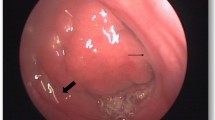Abstract
Purpose
To investigate the effect of thymic stromal lymphopoietin on the development of chronic otitis media with effusion
Materials and methods
This study was conducted on 40 patients who had adenoidectomy operation. The objects were divided into two groups. Group 1; adenoidectomy with chronic serous otitis media, group 2; adenoidectomy without chronic serous otitis media. Serum and tissue thymic stromal lymphopoietin levels were measured by ELISA. Serum and tissue TLSP levels, mast cell count, adenoid size were compared between the groups.
Results
Twenty-four (60%) of patients were female and 16 (40%) were male. Twenty patients (55%) had adenoid hypertrophy with chronic serous otitis media, and 18 (45%) had adenoid hypertrophy without chronic serous otitis media. The mean age of the patients was 6.21 ± 2.31 years. The mean mast cell count was significantly higher in group 1 compared with group 2 (p = 0.017). The mean tissue thymic stromal lymphopoietin measurement was also significantly higher in group 1 than group 2 (p = 0.023). However, there was no significant difference in regards to serum levels between the groups (p = 0.480).
Conclusion
The number of mast cells as well as thymic stromal lymphopoietin levels in the adenoids of children was significantly high in the chronic serous otitis media patients. The release of thymic stromal lymphopoietin from the adenoid tissue plays a role in initiating and maintaining a local inflammatory reaction in the eustachian tube that may lead eventually to middle ear effusion in non-atopic patients.

Similar content being viewed by others
Availability of data and materials
Yes.
Materials and/or code availability
Yes.
References
Tawfik SA, Ibrahim AA, Talaat IM, El-Alkamy SS, Youssef A (2016) Role of bacterial biofilm in development of middle ear effusion. Eur Arch Oto-Rhino-laryngol 273(11):4003–4009. https://doi.org/10.1007/s00405-016-4094-2
Wong CK, Hu S, Cheung PF, Lam CW (2010) Thymic stromal lymphopoietin induces chemotactic and prosurvival effects in eosinophils: implications in allergic inflammation. Am J Respir Cell Mol Biol 43(3):305–315. https://doi.org/10.1165/rcmb.2009-0168OC
Friend SL, Hosier S, Nelson A, Foxworthe D, Williams DE, Farr A (1994) A thymic stromal cell line supports in vitro development of surface IgM+ B cells and produces a novel growth factor affecting B and T lineage cells. Exp Hematol 22(3):321–328
Zielnik-Jurkiewicz B, Stankiewicz-Szymczak W (2016) Pro-inflammatory interleukins in middle ear effusions from atopic and non-atopic children with chronic otitis media with effusion. Eur Arch Oto-Rhino-Laryngol 273(6):1369–1378. https://doi.org/10.1007/s00405-015-3683-9
Miura T, Matsubara A, Kudo N, Hara R, Takahata J, Sasaki A (2018) The expression of thymic stromal lymphopoietin in patients and animal models with eosinophilic otitis media. Acta Otolaryngol 138(5):447–451. https://doi.org/10.1080/00016489.2017.1416170
Saafan ME, Ibrahim WS, Tomoum MO (2013) Role of adenoid biofilm in chronic otitis media with effusion in children. Eur Arch Oto-Rhino-Laryngol 270(9):2417–2425. https://doi.org/10.1007/s00405-012-2259-1
Boita M, Garzaro M, Raimondo L, Riva G, Mazibrada J, Vizio B, Bellone G, Pecorari G, Bucca C, Rolla G, Giordano C (2011) The expression of TSLP receptor in chronic rhinosinusitis with and without nasal polyps. Int J Immunopathol Pharmacol 24(3):761–768. https://doi.org/10.1177/039463201102400322
Ying S, O’Connor B, Ratoff J, Meng Q, Mallett K, Cousins D, Robinson D, Zhang G, Zhao J, Lee TH, Corrigan C (2005) Thymic stromal lymphopoietin expression is increased in asthmatic airways and correlates with expression of Th2-attracting chemokines and disease severity. J Immunol 174(12):8183–8190. https://doi.org/10.4049/jimmunol.174.12.8183
Juszczak HM, Loftus PA (2020) Role of allergy in eustachian tube dysfunction. Curr Allergy Asthma Rep 20(10):54. https://doi.org/10.1007/s11882-020-00951-3
Quaranta N, Iannuzzi L, Gelardi M (2014) Does the type of rhinitis influence development of otitis media with effusion in children? Curr Allergy Asthma Rep 14(11):472. https://doi.org/10.1007/s11882-014-0472-2
Collins MP, Church MK, Bakhshi KN, Osborne J (1985) Adenoid histamine and its possible relationship to secretory otitis media. J Laryngol Otol 99(7):685–691. https://doi.org/10.1017/s0022215100097486
Mou Z, Xia J, Tan Y, Wang X, Zhang Y, Zhou B, Li H, Han D (2009) Overexpression of thymic stromal lymphopoietin in allergic rhinitis. Acta Otolaryngol 129(3):297–301. https://doi.org/10.1080/00016480802225884
Berger G, Ophir D (1994) Possible role of adenoid mast cells in the pathogenesis of secretory otitis media. Ann Otol Rhinol Laryngol 103(8 Pt 1):632–635. https://doi.org/10.1177/000348949410300810 (PMID: 8060058)
Ebenfelt A, Geterud A, Granström G, Lundberg C (1995) Imprints from the oropharyngeal mucosa: a novel method for studies of cell-kinetics and spatial relations between leukocytes, epithelial cells and bacteria in the secretion on the surface of the mucosa. Acta Otolaryngol 115(1):106–111. https://doi.org/10.3109/00016489509133356
Funding
None. The authors did not receive support from any organization for the submitted work.
Author information
Authors and Affiliations
Contributions
All authors contributed to the study conception and design. Conceptualization: TLK, methodology: OD, MCÇ; formal analysis and investigation: SK, CA; writing—original draft preparation: TLK, HS; supervision: DÖ.
Corresponding author
Ethics declarations
Conflict of interest
The authors have no relevant financial or non-financial interests to disclose.
Ethical approval
Study was approved by the appropriate institutional research ethics committee.
Informed consent from all participants
Present.
Consent for publication
Present.
Additional information
Publisher's Note
Springer Nature remains neutral with regard to jurisdictional claims in published maps and institutional affiliations.
Rights and permissions
About this article
Cite this article
Kumral, T.L., Dikker, O., Yıldırım, G. et al. The role of thymic stromal lymphopoietin in the development of chronic otitis media with effusion. Eur Arch Otorhinolaryngol 279, 1937–1942 (2022). https://doi.org/10.1007/s00405-021-06995-z
Received:
Accepted:
Published:
Issue Date:
DOI: https://doi.org/10.1007/s00405-021-06995-z




